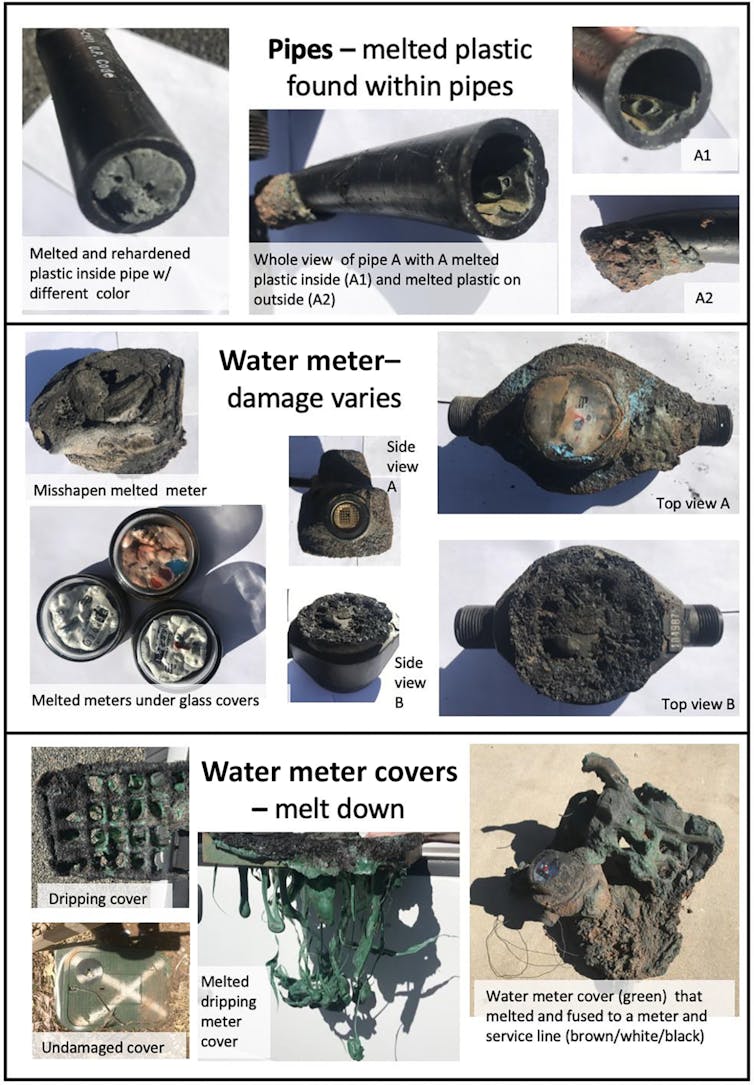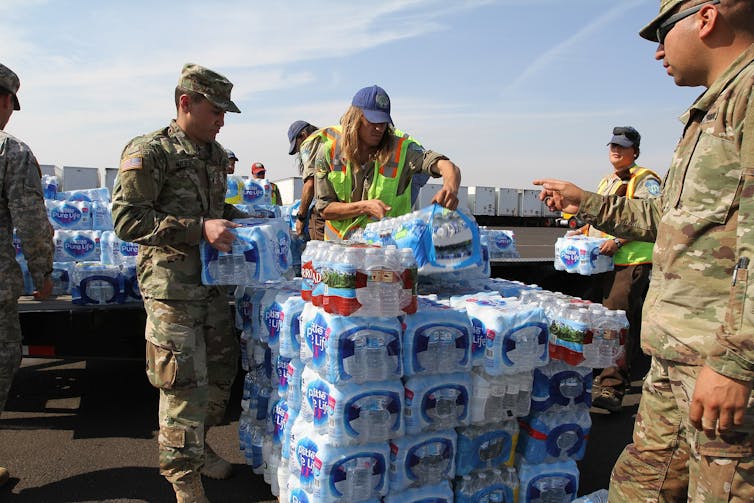
Partway through the 2020 wildfire season, fires are burning large swaths of the western U.S. As in previous years, these disasters have entered populated areas, damaging drinking-water networks. Water systems have lost pressure, potentially sucking in pollutants, and several utilities are warning of possible and confirmed chemical contamination.
We are environmental engineers who help communities affected by disasters, including support for responses to the 2017 Tubbs Fire and 2018 Camp Fire in California. As we concluded in a recently published study of burned areas, communities need to upgrade building codes to keep wildfires from causing widespread contamination of drinking-water systems. They also need to act more aggressively to protect residents from possible toxic exposure immediately after fires.
How wildfires poison water systems
After both the 2017 Tubbs Fire in California’s Sonoma and Napa counties and the 2018 Camp Fire in Butte County, California, drinking-water tests revealed a plethora of acutely toxic and carcinogenic pollutants. Water inside homes was not safe to use—or even to treat.
Water pipes buried underground and inside of buildings were extensively contaminated. Both fires destroyed fire hydrants, water pipes, and meter boxes. Leaks and ruptured hydrants were common.
After the fires passed, testing ultimately revealed widespread hazardous drinking-water contamination in areas affected by both fires. Evidence suggests that the toxic chemicals originated from a combination of burning vegetation, structures, and plastic materials.
Chemicals in the air may have also been sucked into hydrants as water pipes lost pressure. Some water-system plastics decomposed and leached chemicals directly into water. Toxic chemicals then spread throughout pipe networks and into buildings.
Limited water testing by state and local agencies showed that benzene and naphthalene were present at levels that could cause immediate physical harm. These chemicals, as well as methylene chloride, styrene, toluene, and vinyl chloride, exceeded limits for longer-term exposure.
All of these substances are volatile organic compounds—chemicals that readily evaporate into the air at room temperature. Many of them cause cancer. All can cause vomiting, diarrhea, and nausea after a brief high-concentration exposure.
Simply running a cold water faucet can release volatile organic compounds from tap water into the air. Heating water for showers or cooking makes them enter the air even faster, creating a more severe inhalation risk. Some can also be absorbed through the skin.

Protecting the public
In our view, agencies should not underestimate health hazards posed by fire-damaged drinking-water systems. After the CZU Lightning Complex Fire burned parts of San Mateo and Santa Cruz counties, California officials and a water utility issued and reissued an advisory allowing children to bathe in potentially contaminated drinking water. Five days later, when limited test results became available, both organizations recanted and said no one should bathe in the water.
To avoid this kind of error, we recommend issuing “Do Not Use” orders in the wake of major fires to protect the public before water testing results are available. We believe it is acceptable to use water for fire fighting and toilet flushing, but not for purposes that involve ingestion, skin exposure, or inhalation, such as bathing or cooking.
Under no circumstance should people be told to smell the water to determine its safety, as officials recommended for months after the Camp Fire. Many harmful chemicals have no odor, so only testing can determine safety.
Advisories to boil water should not be used, since boiling speeds up the release of toxic chemicals into the air. Nor do we recommend “Do Not Drink/Do Not Boil” advisories, which allow bathing in contaminated water.
Before agencies lift or modify advisories, we believe they should be required to carry out thorough chemical screens of water systems. Too often, officials charged with protecting public health fail to take this step, exposing people to needless risk. More typically, they act like California’s San Lorenzo Valley Water District, which lifted a post-wildfire “Do Not Drink/Do Not Boil” order in parts of its territory on September 7 with a notice to ratepayers that “If test results reveal anything harmful, you will be advised promptly.”

Agencies also need to test buildings for water contamination. Home drinking-water quality can differ from room to room, so reliable testing should sample both cold and hot water at many locations within each building.
While infrastructure is being repaired, survivors need a safe water supply. Water-treatment devices sold for home use, such as refrigerator and faucet water filters, are not approved for extremely contaminated water, although sales representatives and government officials may mistakenly think the devices can be used for that purpose. While survivors wait for safe water to return, government agencies should ensure that reliable emergency water supplies are available.
Update building codes for future fires
Our research underscores that community building codes are inadequate to prevent wildfire-caused pollution of drinking water and homes.
Adopting codes that require builders to install fire-resistant meter boxes and place them farther from vegetation would help prevent infrastructure from burning so readily in wildfires. Concrete meter boxes and water meters with minimal plastic components would be less likely to ignite. Some plastics may be practically impossible to make safe again, since all types are susceptible to fire and heat.
Installing one-way valves, called backflow prevention devices, at each water meter can prevent contamination rushing out of the damaged building from flowing into the larger buried-pipe network. Water main-shutoff valves and water sampling taps should exist at every water-meter box. Sample taps can help responders determine water safety quickly.
As the past several years have shown, many communities need to be better prepared for wildfires. Two years after the Camp Fire, the town of Paradise, California, is still clearing and repairing its water system, at an estimated cost of up to $150 million. We believe the time to upgrade in other towns is now.
-Andrew J. Whelton is an associate professor of civil, environmental, and ecological engineering at Purdue University. Caitlin R. Proctor is a Lilian Gilbreth postdoctoral fellow at Purdue University. This post originally appeared at The Conversation.
Weekly Newsletter
Get building science and energy efficiency advice, plus special offers, in your inbox.















11 Comments
Perhaps insurance companies will discourage people from building in areas prone to wildfires.
John,
That would mean nobody could build in Arizona, Nevada, Montana, California, Wyoming, etc., basically the entire western United States, in any low to high desert, prairie to mountain range. That is not feasible.
Even coastal range Oregon caught on fire this year.
Not necessarily, if anything it would result in higher density. After all neither Bozeman, Denver, Portland, Reno, Las Vegas, San Francisco, LA, or Phoenix AZ are susceptible to burning down because of wildfires.
John,
That is not true. Those areas are also susceptible. See article:
https://www.corelogic.com/blog/2019/10/top-15-metro-areas-with-wildfire-risk.aspx
Yes, higher density in metro areas is just pushed to the outskirts of the major cities as there is no more room to grow, except outwards.
On a different note. High density cities have other problems. Most recently, the COVID19 pandemic showed that dense packed cities become death zones in pandemics. New York City was a clear example of that. Recent stats show that people are moving OUT of New York City due to what happened earlier this year with the outbreak. When you pack people into high density cities like rats & roaches, you will have problems in pandemics. In addition, the rioting and civil unrest has also shown that major cities are susceptible to major civil unrest and arson. If not for the fire department response, many major cities could have seen devastating fires caused by arson.
The risk is low. In any case with higher density (which is what all environmentalist really want for everyone else rather than themselves) it's easier to build a buffer and build up (vertically). Plus it's much easier to defend a town from wildfire vs having to defend 10-20 residences strewn along 5 miles of a dirt road.
CV19 is easier to monitor and control in cities and due to the density it's easier for individuals to receive what they need to survive rather than having to jump in a car and drive 5 miles into town.
Yes some people may be leaving NYC but generally they're extremely wealthy, and are moving into nearby suburbs where density is still high. At least that's what I've been told by family and a local realtor in Stamford/Greenwich CT.
Civil unrest in cities is overblown because in almost all cases it's highly localized to one small part of a city. Think of a couple of city blocks.
In any case insurance is the most equitable way to handle the problem of wildfires because the individual homeowners rather than the taxpayer carry a lot of the risk. Well, that is until the homeowners get the govt to make taxpayers carry more of the risk. Some people do think they have a god given right to live in the woods and if it becomes too expensive then the taxpayers should subsidize it.
Even after the water is declared "safe", I'd use a reverse osmosis filter.
Given the title of the blog, the opening picture showing a plane discharging what likely is fire-retardant chemical near a house suggests contamination of drinking water by such chemicals. Yet no mention of that practice appears in the blog. If there is no such connection, why use such a misleading picture?
agreed. The flame retardant chemicals leach into the ground and contaminate water.
If only they were actually chemicals instead of clay/sea weed and water.
The red stuff is mostly benign (Water, Clay/Guar Gum, iron oxide for color). Sometimes fertilizer is added in order to assist with seed germination.
Love the recommendations to test water in every room of the house. Who pays for that? And when? And how are these water systems able to ensure people have safe water in the aftermath of a fire when hundreds/thousands of properties have burned? Where does the money come from? Or the people to manage such a thing? These water districts are usually tiny, private and badly funded at the best of times, often with only a few employees (if any at all). The recommendations are delusional nonsense.
Log in or create an account to post a comment.
Sign up Log in